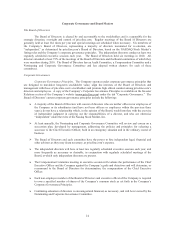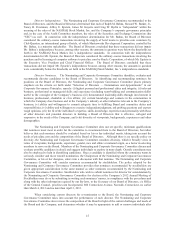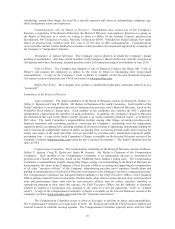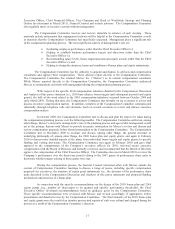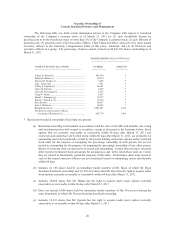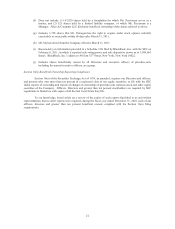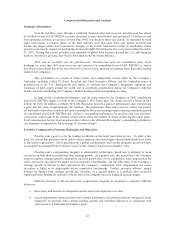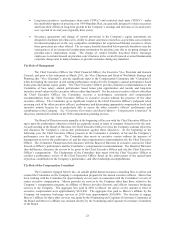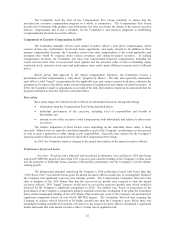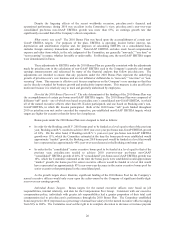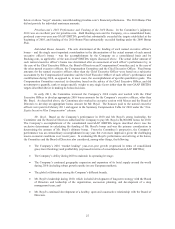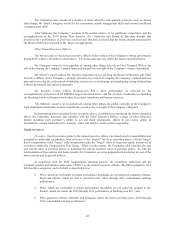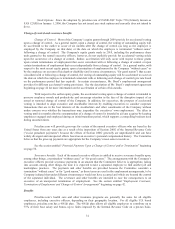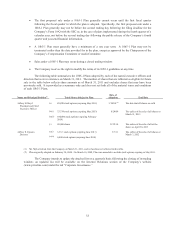Priceline 2010 Annual Report Download - page 25
Download and view the complete annual report
Please find page 25 of the 2010 Priceline annual report below. You can navigate through the pages in the report by either clicking on the pages listed below, or by using the keyword search tool below to find specific information within the annual report.23
x Long-term incentives - performance share units (“PSUs”) and restricted stock units (“RSUs”) - under
the stockholder-approved priceline.com 1999 Omnibus Plan, are generally designed to retain executives
and focus their efforts on long-term growth in the Company’s earnings and increases to its stock price
over a period of several years (typically three years).
x Severance agreements and change of control provisions in the Company’s equity instruments are
designed to facilitate priceline.com’s ability to attract and retain executives as priceline.com competes
for talented employees in the very competitive marketplace for experienced Internet executives, where
these protections are often offered. The severance benefits described below provide benefits to ease the
consequences of an unexpected employment termination by priceline.com due to on-going changes in
priceline.com’s employment needs. The change of control benefits described below encourage
employees to remain focused on priceline.com’s business in the event of rumored or actual fundamental
corporate change and, in many instances, to provide assistance during any transition.
The Role of Management
The Chief Executive Officer, the Chief Financial Officer, the Executive Vice President and General
Counsel, and prior to his retirement in March 2011, the Vice Chairman and Head of Worldwide Strategy and
Planning (the “Vice Chairman”), provide significant input to the Compensation Committee (the “Committee”)
when developing the structure of and setting performance metrics for the Company’s annual performance based
bonus plan and annual equity grants. The Chief Executive Officer provides detailed recommendations to the
Committee of base salary, annual performance based bonus plan opportunities and awards and long-term
incentive award values for the executive officers other than himself. For the named executive officers other than
the Chief Executive Officer, the Committee receives a performance assessment and compensation
recommendation from the Chief Executive Officer in executive session without the presence of the other
executive officers. The Committee gives significant weight to the Chief Executive Officer’s judgment when
assessing each of the other executive officers’ performance and determining appropriate compensation levels and
incentive awards because he is particularly able to assess the other executive officers’ performance and
contributions to the Company. See “Corporate Governance and Board Matters – Compensation Committee” in
this proxy statement for details on the 2010 compensation planning process.
The Board of Directors meets annually at the beginning of the year with the Chief Executive Officer to
agree upon his performance objectives (which are generally stated in terms of company objectives) for the year.
At each meeting of the Board of Directors, the Chief Executive Officer reviews the Company’s annual objectives
and discusses the Company’s year-to-date performance against those objectives. At the beginning of the
following year, the Chief Executive Officer presents to the Committee a summary of his and the Company’s
performance over the past year. The Committee then meets in executive session without the presence of
management to review the performance of, and develop compensation recommendations for, the Chief Executive
Officer. The Committee Chairperson then discusses with the Board of Directors in executive session the Chief
Executive Officer’s performance and the Committee’s compensation recommendations. The Board of Directors
then deliberates, discusses the review to be given to the Chief Executive Officer and sets the Chief Executive
Officer’s compensation. The Chairperson of the Committee then meets with the Chief Executive Officer to
conduct a performance review of the Chief Executive Officer based on his achievement of the agreed-upon
objectives, contribution to the Company’s performance, and other leadership accomplishments.
The Role of the Compensation Consultant
The Committee engaged Mercer Inc., an outside global human resources consulting firm, to advise and
counsel the Committee on the Company’s compensation program for the named executive officers. Mercer has
been working with the Committee for approximately eleven years in connection with the Committee’s review of
senior executive compensation. Mercer provides no services to the Company other than those related to the
Company’s compensation program; an affiliate of Mercer provides directors and officers insurance brokerage
services to the Company. The aggregate fees paid in 2010 to Mercer for advice on the amount or form of
executive compensation were approximately $123,845. The aggregate fees paid to Mercer’s affiliate by the
Company for insurance brokerage services in 2010 were approximately $160,000. The decision to engage
Mercer’s affiliate for these other services was made by the Nominating and Corporate Governance Committee of
the Board and Mercer’s affiliate was retained directly by the Nominating and Corporate Governance Committee
of the Board.



